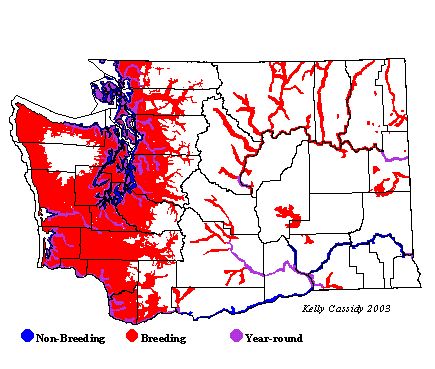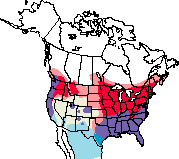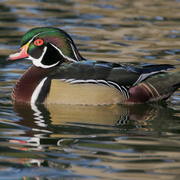Wood Duck
General Description
Male Wood Ducks are flamboyant in breeding plumage, practically unmistakable with their brightly colored chestnut and yellow bodies, green droop-crested heads, bright red bills, and bold white barring on their faces and bodies. Females are drabber, with subtle iridescence on overall grayish-brown bodies, spotted flanks, and a white teardrop surrounding each eye. Juveniles appear similar to females, as do non-breeding males in eclipse plumage (from June to September), although they have the red bill and white facial markings.
Habitat
Rarely seen on marine waters, the Wood Duck is a bird of wooded wetlands and slow-moving, tree-lined rivers, with a preference for deciduous-tree habitats. This cavity-nester requires either a natural cavity or nest box to raise its young.
Behavior
Wood Ducks forage in the water by taking food from the surface and up-ending to reach food underneath. They also graze on land. Pairs form on the wintering grounds, and males attract females by showing off their brightly colored plumage. Females demonstrate strong fidelity to the sites where they hatched (philopatry), and they lead their mates back to those sites in the spring.
Diet
Aquatic plant seeds make up the majority of the diet. Insects and other aquatic invertebrates are also eaten, especially by young birds. In areas with oak trees, acorns are a significant source of food.
Nesting
Wood Ducks nest in cavities near or above water, up to 65 feet high. The most common natural cavities are Pileated Woodpecker holes, but artificial nest boxes are used as well. The cavity is lined with down. The female lays 9 to 14 eggs and incubates them for 25 to 35 days. After the female begins incubation, the pair breaks up. After one day in the nest, the young leap to the ground or water, often quite a long jump. The young can swim and feed themselves, but the female continues to tend them for 5 to 6 weeks. She leaves before they can fly, however. They fledge when they are 8 to 9 weeks old.
Migration Status
Many Wood Ducks are short-distance migrants, but almost 75% of the Wood Ducks in the Pacific Flyway are non-migratory. Those that are migratory fly from British Columbia through western Washington and winter in the Central Valley of California. Some western Washington breeders do not appear to be migratory, although most are. Those from eastern Washington are also migratory. Males gather in a post-breeding flock and molt before the fall migration.
Conservation Status
Wood Ducks declined seriously during the late 19th Century due to over-hunting and habitat loss, and were threatened with extinction early in the 20th Century. Legal protection, beginning in 1918 with the Migratory Bird Treaty Act, and major initiatives to provide nest boxes in appropriate habitat have helped the Wood Duck recover to healthy numbers. Expanding beaver populations throughout the Wood Duck's range have also helped the population rebound as beavers create an ideal forested wetland habitat for Wood Ducks.
When and Where to Find in Washington
Wood Ducks are common breeders from March through August in lowlands west of the Cascades. In eastern Washington, they are uncommon in the central Columbia Basin, but found more commonly in the lowlands, especially along major river valleys in northeastern Washington. In winter, they are uncommon, but still present in some areas west of the Cascades, and wintering numbers appear to be increasing.
 Abundance
Abundance
| Ecoregion | Jan | Feb | Mar | Apr | May | Jun | Jul | Aug | Sep | Oct | Nov | Dec |
|---|---|---|---|---|---|---|---|---|---|---|---|---|
| Oceanic | ||||||||||||
| Pacific Northwest Coast | R | R | R | F | F | F | F | F | U | R | R | R |
| Puget Trough | U | U | F | F | C | F | F | F | F | U | U | U |
| North Cascades | U | C | C | C | C | C | C | C | U | |||
| West Cascades | U | U | U | F | C | C | C | F | U | U | U | U |
| East Cascades | U | F | F | F | F | F | F | U | R | R | ||
| Okanogan | U | C | F | F | F | F | F | C | C | |||
| Canadian Rockies | F | F | F | F | F | F | ||||||
| Blue Mountains | U | U | U | U | U | R | R | |||||
| Columbia Plateau | F | F | F | F | F | F | F | F | F | F | F | F |
Washington Range Map

North American Range Map


Family Members
 Fulvous Whistling-DuckDendrocygna bicolor
Fulvous Whistling-DuckDendrocygna bicolor Taiga Bean-GooseAnser fabalis
Taiga Bean-GooseAnser fabalis Greater White-fronted GooseAnser albifrons
Greater White-fronted GooseAnser albifrons Emperor GooseChen canagica
Emperor GooseChen canagica Snow GooseChen caerulescens
Snow GooseChen caerulescens Ross's GooseChen rossii
Ross's GooseChen rossii BrantBranta bernicla
BrantBranta bernicla Cackling GooseBranta hutchinsii
Cackling GooseBranta hutchinsii Canada GooseBranta canadensis
Canada GooseBranta canadensis Mute SwanCygnus olor
Mute SwanCygnus olor Trumpeter SwanCygnus buccinator
Trumpeter SwanCygnus buccinator Tundra SwanCygnus columbianus
Tundra SwanCygnus columbianus Wood DuckAix sponsa
Wood DuckAix sponsa GadwallAnas strepera
GadwallAnas strepera Falcated DuckAnas falcata
Falcated DuckAnas falcata Eurasian WigeonAnas penelope
Eurasian WigeonAnas penelope American WigeonAnas americana
American WigeonAnas americana American Black DuckAnas rubripes
American Black DuckAnas rubripes MallardAnas platyrhynchos
MallardAnas platyrhynchos Blue-winged TealAnas discors
Blue-winged TealAnas discors Cinnamon TealAnas cyanoptera
Cinnamon TealAnas cyanoptera Northern ShovelerAnas clypeata
Northern ShovelerAnas clypeata Northern PintailAnas acuta
Northern PintailAnas acuta GarganeyAnas querquedula
GarganeyAnas querquedula Baikal TealAnas formosa
Baikal TealAnas formosa Green-winged TealAnas crecca
Green-winged TealAnas crecca CanvasbackAythya valisineria
CanvasbackAythya valisineria RedheadAythya americana
RedheadAythya americana Ring-necked DuckAythya collaris
Ring-necked DuckAythya collaris Tufted DuckAythya fuligula
Tufted DuckAythya fuligula Greater ScaupAythya marila
Greater ScaupAythya marila Lesser ScaupAythya affinis
Lesser ScaupAythya affinis Steller's EiderPolysticta stelleri
Steller's EiderPolysticta stelleri King EiderSomateria spectabilis
King EiderSomateria spectabilis Common EiderSomateria mollissima
Common EiderSomateria mollissima Harlequin DuckHistrionicus histrionicus
Harlequin DuckHistrionicus histrionicus Surf ScoterMelanitta perspicillata
Surf ScoterMelanitta perspicillata White-winged ScoterMelanitta fusca
White-winged ScoterMelanitta fusca Black ScoterMelanitta nigra
Black ScoterMelanitta nigra Long-tailed DuckClangula hyemalis
Long-tailed DuckClangula hyemalis BuffleheadBucephala albeola
BuffleheadBucephala albeola Common GoldeneyeBucephala clangula
Common GoldeneyeBucephala clangula Barrow's GoldeneyeBucephala islandica
Barrow's GoldeneyeBucephala islandica SmewMergellus albellus
SmewMergellus albellus Hooded MerganserLophodytes cucullatus
Hooded MerganserLophodytes cucullatus Common MerganserMergus merganser
Common MerganserMergus merganser Red-breasted MerganserMergus serrator
Red-breasted MerganserMergus serrator Ruddy DuckOxyura jamaicensis
Ruddy DuckOxyura jamaicensis

